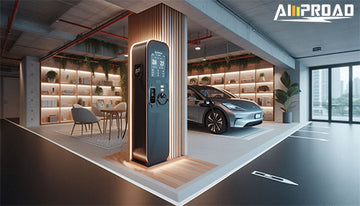
The rise of electric vehicles (EVs) has undoubtedly brought many advantages, including reduced emissions and lower operating costs. However, it is essential to consider some drawbacks that may impact potential buyers or current owners. This exploration delves into three notable disadvantages of electric vehicles: limited range and charging time, higher initial costs, and infrastructure limitations. Each of these factors plays a crucial role in the overall ownership experience, especially regarding the use of charging solutions like the AMPROAD level 2 charger.
What Is the Limitation of Range and Charging Time in Electric Vehicles?
One of the primary concerns associated with electric vehicles is their limited range compared to traditional gasoline-powered vehicles. While advances in battery technology have significantly improved EV ranges, many models still fall short of the distances that gasoline cars can achieve.
How Does Limited Range Affect Long-Distance Travel?
Electric vehicles typically offer a range of around 150 to 370 miles on a single charge, depending on the model and battery size. This limitation can be a significant disadvantage for drivers who frequently engage in long-distance travel. In contrast, gasoline vehicles can be refueled in a matter of minutes, allowing for uninterrupted journeys. The need for more frequent charging stops can disrupt travel plans and necessitate careful route planning.
What Are the Charging Time Challenges?
Charging times for electric vehicles can also pose a challenge. While a level 2 EV charger can provide a decent charge, it often takes several hours to fully replenish an EV's battery. For instance, using an AC 80A level 2 EV charger at home may reduce charging times compared to a standard outlet, but it is still much longer than refueling a gasoline vehicle. This difference can be inconvenient, particularly for those who require a quick turnaround after using their vehicle.
What Is the Impact of Charging Infrastructure?
The charging infrastructure can further complicate the situation. While public fast-charging stations are becoming more prevalent, they are not universally available. Many EV owners rely on home or portable EVSE options, which typically offer slower charging speeds than dedicated fast chargers. This discrepancy can extend the time needed to recharge an EV, particularly for those without access to high-capacity charging stations.
Why Are Electric Vehicles More Expensive Initially?
Another significant drawback of electric vehicles is their higher initial cost compared to gasoline-powered vehicles. The price tag for most EVs is typically higher due to several factors.
What Contributes to the Higher Upfront Cost?
The cost of batteries is one of the primary contributors to the higher price of electric vehicles. Although battery prices have been decreasing over the years, they still represent a substantial portion of the overall vehicle cost. Additionally, electric vehicles may come equipped with advanced technology features that add to their initial price.
How Do Home and Portable Charger Costs Affect Total Ownership?
The cost of owning an electric vehicle extends beyond the vehicle itself. EV owners must also consider the expense of purchasing and installing a portable or home EV charger. While charging at home is often more convenient, the upfront investment can be significant. For instance, an AMPROAD level 2 EV charger represents a reliable and efficient option, but it adds to the overall financial commitment of owning an electric vehicle.
What Are the Infrastructure Limitations for Electric Vehicles?
The availability of charging stations is another crucial consideration for potential EV owners. While public charging stations are on the rise, many areas still lack adequate infrastructure to support electric vehicle charging needs.
How Does Limited Charging Infrastructure Impact EV Owners?
In certain regions, finding a public charging station can be a challenge, particularly in rural or less populated areas. This limitation can lead to range anxiety, where drivers worry about running out of battery power before reaching a charging point. Consequently, potential buyers may hesitate to switch to electric vehicles due to concerns about charging availability.
How Do Home and Portable Chargers Mitigate Infrastructure Issues?
Home and portable chargers provide a convenient solution for many EV owners, allowing them to charge their vehicles overnight or during downtime. However, these solutions may not suffice for those who frequently travel long distances or require charging while away from home. For example, drivers who rely solely on a portable EVSE may find themselves struggling to maintain adequate charge levels during longer trips, especially if charging stations are sparse.
The Reality of Electric Vehicles
While electric vehicles offer numerous benefits, potential owners should be aware of the drawbacks associated with their use. Limited range and charging time can hinder long-distance travel and add complexity to ownership. Higher initial costs can make electric vehicles less accessible, especially when factoring in home and portable charging solutions. Lastly, infrastructure limitations may deter some drivers from making the switch to electric mobility.
Understanding these challenges is essential for anyone considering an electric vehicle. As the market continues to evolve, advancements in technology and infrastructure are likely to mitigate some of these issues. For those who prioritize sustainability and innovation, electric vehicles remain a compelling choice despite the drawbacks. By staying informed and choosing reliable solutions like the AMPROAD level 2 EVSE charger, owners can enjoy a seamless electric driving experience while navigating the challenges associated with EV ownership.


